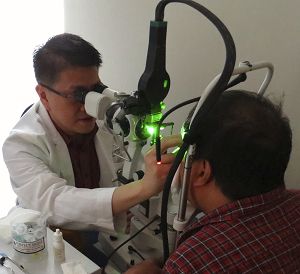Copyright © 2014: Manila Retina Specialists All Rights Reserved
 Fig 9 Dr. Uy performing panretinal photocoagulation for a patient with diabetic retinopathy.
Fig 9 Dr. Uy performing panretinal photocoagulation for a patient with diabetic retinopathy.
This is indicated for patients with macular edema due to branch vein occlusion, diabetes, or certain cases of Polypoidal Choroidal Vasculopathy, or retinal tears. It may also be used for Proliferative Diabetic Retinopathy.
The patient is usually given dilating drops, after which a special lens is placed in the eye after giving numbing drops. Multiple burns from a diode laser are then applied to the macula, or the peripheral retina, depending upon where the damage is located.
Many people are afraid of laser, because they say that laser “blinded “ someone they know. Laser does not usually cause blindness, but most people that have poor vision after laser are usually those who have far advanced diabetic retinopathy. The membranes contract and produce a traction/ or rhegmatogenous retinal detachment.
Alternatively, some people who really need surgery opt for laser surgery because it is more affordable. Laser surgery is no substitute for surgery, if the latter is indicated.
If used appropriately, laser photocoagulation can reduce the rate of blindness due to diabetic retinopathy, or prevent a retinal tear from progressing to a full blown retinal detachment.
